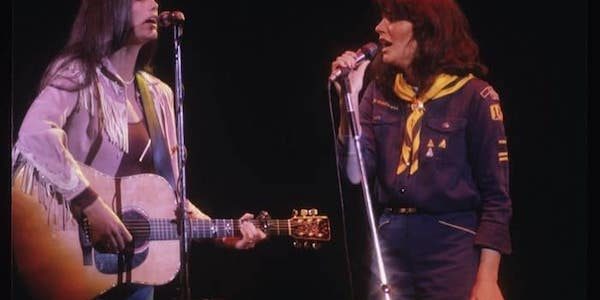
ReelBob: ‘Linda Ronstadt: The Sound of My Voice’ ★★★½
By Bob Bloom
Since the late 1960s, Linda Ronstadt has been a musical force. She transcended genre, performing rock, country, ballads, Gilbert & Sullivan, standards and Mexican songs that captivated audiences in clubs, stadiums and arenas, albums and CD collectors and radio listeners.
Ronstadt sang songs that touched her and called to her. She could not — and would not — be defined or constricted by category.
And Ron Epstein and Jeffrey Friedman’s documentary, “Linda Ronstadt: The Sound of My Voice,” puts an exclamation point to that definition.
Music, Ronstadt explains in the movie, always has been a part of her life. Her family would sing Mexican songs her father taught the family around the dinner table, in the living room or the car.
She sang in Spanish and spoke English.
In 1964, at 18, she moved to Los Angeles to be with her brother and pursue a musical career. She first came to national attention as lead singer for The Stone Poneys, but soon left the group to start a solo career.
Ronstadt’s impact and contributions to the music industry are often overlooked because she was not a singer-songwriter like many of her contemporaries.
She would hear a song and cover it in her own style, usually making it better than the original — as some fellow artists admit in the film.
A plethora of friends and singers offer their views on Ronstadt’s career and her voice, including Dolly Parton, Emmylou Harris, Jackson Browne, Ry Cooder, Bonnie Raitt, Aaron Neville and Don Henley, filmmaker and former music journalist Cameron Crowe, former “Los Angeles Times” music critic Robert Hilburn, her manager, Peter Asher, and record executive David Geffen.
Surprisingly, Ronstadt had “very little confidence” in herself, one executive said. Asher tells the filmmakers that ‘she never thought she was as good as she was.”
Musically, Ronstadt had a restless spirit and would take chances many of her contemporaries would shun. She performed “The Pirates of Penzance” on stage in New York, performed traditional Mexican songs at a mariachi festival and cut an album of standards that had been sung by Ella Fitzgerald, Billie Holiday and Frank Sinatra.
You feel from the movie that Ronstadt was not competitive. She made an album with Dolly Parton and Emmylou Harris and sang with Aaron Neville.
She was very generous. When Henley, who was her drummer on a tour, and Glenn Frey, who was a guitarist in her band, hit it off musically, she encouraged them to leave and form their own group.
The movie also covers her relationship with then (and now) California Gov. Jerry Brown. Their affair was spotlighted in the media — even making the cover of “People.”
A disappointing aspect of “The Sound of My Voice” is its lack of depth about Ronstadt’s later life. She gave up touring in 2009 and retired in 2011. Shortly thereafter, diagnosed with Parkinson’s disease, which affected her voice.
One of the last shots of the movie is Ronstadt, at home in early 2019, having difficultly singing with her cousin and nephew because of the quaver in her voice.
It is sad seeing Ronstadt and how the disease has impacted her.
Overall, “Linda Ronstadt: The Sound of My Voice” is a treasure, a tune-filled tribute to a magnificent talent who loved to sing and passed on that joy to millions who breathed in her exquisite gift.
I am a founding member of the Indiana Film Journalists Association. My reviews appear at ReelBob (reelbob.com) and Rottentomatoes (www.rottentomatoes.com). I also review Blu-rays and DVDs. I can be reached by email at bobbloomjc@gmail.com or on Twitter @ReelBobBloom. Links to my reviews can be found on Facebook, Twitter and LinkedIn.
LINDA RONSTADT: THE SOUND OF MY VOICE
3½ stars out of 4
(PG-13), drug material, language